Ez a cikk kb. 3 perc, videókkal együtt kb. 18 perc, de az életedet teheti jobbá. Megéri? Meg!
Mi is az az Astanga jóga? És mitől dobja el az agyad?
Az astanga jóga az egyik legdinamikusabb és legintenzívebb jóga forma, amely az utóbbi évtizedekben nagy népszerűségnek örvend.
1 mondatban – mi is az astanga jóga?
Egy előre kitalált, egy szuperzseni által az előző 5000 év ászanáiból (ezek kb. gimnasztikai gyakorlatok, légzéssel kísérve) megalkotott 6 gyakorlat-sor, amit egyszer megtanulsz és egész életedben bárhol bármikor tudod csinálni. És: sokkal jobban leszel tőle: testileg, lelkileg.
Nem a zsírégető teától. Az antidepresszánstól. A bortól (bár az utóbbit én is megkóstolom, de csak módjával). És így tovább.
Egy dolog – ami csak Rajtad múlik: csinálod-e. Ha csinálod: sokkal jobb lesz. Minden.
Kezdjük azzal: mire jó és miért olvasd el ezt itt?
Az astanga jóga, hogy milyen – leírni: leírhatatlan. Azt mondják – mint a jógára úgy általában: “experiential stuff” – kissé ferdítve a magyar mondást: “ha nem lenne, ki kéne találni” – ezt meg: ki kell próbálni.
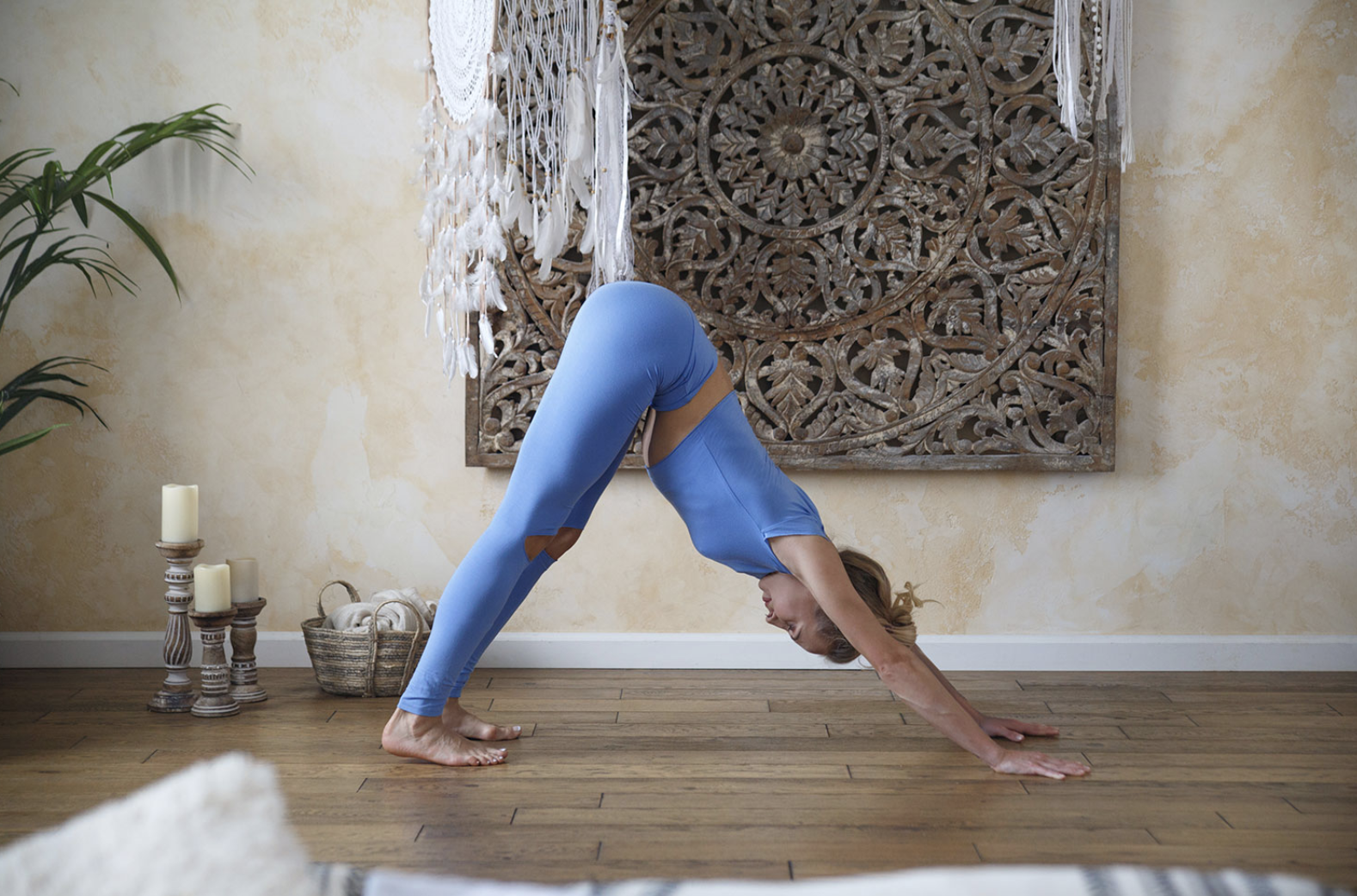
Csak pár szóban – az astanga jóga egyszerre ad:
-erőt
-rugalmasságot
-egyensúlyt – fizikait és szellemit (ha pörögsz, lenyugtat, ha lusta vagy vagy fáradt, felkelt, felpörget, kóla és kávé nélkül is)
-nyugalmat – erről külön cikkek és tanulmányok tömege szól, hogyan nyugtat le a jóga és az astanga jóga
-“flow” érzést: közvetlen és átvitt értelemben is, lásd lejjebb
Megjegyzés: a teljes neve: astanga vinyasa flow. Ez sem – ahogy semmi sem – véletlen.
És ami talán a legfontosabb: még sok minden mást: fejlődést, tükröt, növekedést.
Minden benne van, amit a motivációt kutatók ezelőtt 50 évvel megfogalmaztak: achievement, advancement, growth, work itself, responsibility.
Azaz: elérsz dolgokat, előrefelé mégy, növekedsz, magadnak dolgozol, felelős vagy.
És: egész napos lebegést – erős, valódi mellékhatások nélküli “kábítószer” amitől – tisztábban látsz.
Mi is jóga? Meg fogsz lepődni, mert Te is csinálod, remélhetőleg
Mellékes megjegyzésnek tűnhet: az egész cikket az után határoztam el, hogy megírom, hogy láttam ezt a videót: Tedd meg ezt az egyet, hogy leküzdd a szorongást.
Azaz: minden gyakorlat jóga, ami a lelked, a tested és az elméd egyensúlyba hozza. Minden.
Még a fenti videóban látható “gyakorlat” is. Mondjuk úgy: ez az első ászana.
A drog és az antidepresszáns nem – az több kárt csinál, mint hasznot (a kivételes esetektől eltekintve, amikor azért szeded mert elkerülhetetlen, mert nincs más választás – ideiglenesen. A gond az ilyen ideiglenes dolgokkal mindig az, hogy benneragad az ember).
Majd lentebb leírom miért is jutott eszembe ez a cikk erről a videóról.
A jóga…akkor ücsörögsz 1 órát?! Nem. Az astanga – ún. dinamikus, flow jóga. És az első astanga sorozat: jóga-terápia
Az astanga jóga legfontosabb jellemzője, hogy állandóan mozgásban vagy a sorozat alatt. Patthabi Jois 6 sorozatot rakott össze, ebből a legtöbben a világon egy életen át az első sorozatot, amelynek neve a “Primary Series” (most meglepődtetek!?) – amúgy a “hivatalos neve” yoga chikitsa – aminek a fordítása: yoga therapy azaz jóga terápia. Ez sem véletlen. Ahogy: amikor gyakorlod, rájössz: tényleg semmi nem véletlen, ami az astanga jógában “van”.
Egy kis videó – ha van 5 perced és még ha pasi vagy, akkor is könnyezni fogsz: egy veterán és az astanga jóga (ebben a videóban DDP yoga-nak hívja a jóga-instruktor, de bocsássuk meg neki, amerikai – az összes ászana, ami a videóban van, és ahogy gyakorolja: ez bizony: astanga jóga). A történet onnan, hogy 15 éve nem tud rendesen járni – odáig, hogy… nem lövöm le a poént.
Ez talán az egyik legjobb reklám.
Milyen előnyei vannak az első sorozatnak? Miért terápia
Az első sorozat egy gyógyító gyakorlat. Alaphelyzetbe állítja a testet, így mélyebb szinten dolgozhat. Meditációra, pránájámára (ez a légzőgyakorlatok a jógában) és a test felkészítésére szolgál a további sorozatokra és “fokozatokra”.
Egyensúlyt hoz mind a szimpatikus, mind a paraszimpatikus idegrendszerben.
Minden testhelyzet elősegíti a véráramlást a célzott izmokhoz. Emiatt meglágyulnak és rugalmasabbá válnak. Ez a keringés aztán a szerveket is tisztítja. Mozgásra kényszeríti a pangó energiát és a méreganyagokat amik így távoznak belőled.
Kell-e Neked a gyógyítás, a gyógyulás? Nos? 🙂
Ki gyakorolhatja az astangát? Fiatalok, öregek, betegek?!? Te?!?
Patthabi Jois egyik mondása:
“Bárki gyakorolhat. A fiatal tud gyakorolni. Az öreg tud gyakorolni. Nagyon öreg ember tud gyakorolni. Aki beteg, gyakorolhat. Akinek nincs ereje, gyakorolhat. Kivéve a lusta embert; A lusta ember nem gyakorolhat astanga jógát.”

Én dupla gerincsérvvel kezdtem. Műteni akartak. Amitől még merevebbé váltam volna.
Most 12 éve jógázom. Előtte rettegésben éltem jónéhány évet: “mikor marad megint úgy a derekam, a hátam!??”
Elkezdtem – 6 évre rá mentem újra az orvosomhoz – a két sérvnek: semmi nyoma. Eltűnt. A gerincorvosom (Magyarország egyik szupersztár gerinc-orvosa, mellesleg) szerint: “Péter, ha mindenki úgy betartaná, mit mondok neki, mint Te, nem lenne páciensem.”
A másik személyes sztori: vesegörcsök közötti szünetben (vesekő…) a kórházban nyomtam a kórteremben az ágyak között – mert jobb lett tőle. A fél kórterem és az ápolók közül 2 jógázni akart jönni utána. Elkérték az elérhetőséget, hol lehet ilyet. Nem viccelek.
Mitől “flow”?
75 pozícióból áll, és egy-másfél órát vesz igénybe. A sorozat minden pozíciója összekapcsolódik a következővel, és mellé a légzés folyamatos szinkronban van a mozgással. Elárulom: spoliler(!!!): a légzés és a folyamatos mozgás együtt: a lényeg. Meg a tekintet: az ászanák során hova nézel éppen. Ez a három. Ebből jön együtt a “flow”.
Mit nem adnál a “flow” érzésért, ugye!? Hát: megtaláltad!
Ez azt jelenti, hogy minden testrészünk mozgásban van, és az energia áramlik az egész testen keresztül. Az astanga jóga dinamikája lehetővé teszi, hogy fokozott erőt, rugalmasságot, állóképességet, stabilitást és egyensúlyt nyújtson.
Az astanga jóga azt is jelenti, hogy minden gyakorlást azonos sorrendben és azonos mennyiségben (5 lélegzetig kitartva) kell elvégezni, hogy elérjük a test és az elme egységét. Az astanga jóga során fontos a légzés, amely segít az elmének és a testnek az összpontosításban, és támogatja a meditáció, a befelé-figyelés állapotát.
Az astanga jóga egy olyan jógafajta, amely minden alkalommal kihívást jelenthet azoknak is, akik már rendelkeznek jóga tapasztalattal, és ugyanakkor kezdők számára is elérhető.
Mitől “tükör”?
Belegondoltál már – milyen unalmas a kiszámíthatóság? Amikor mindig ugyanazt kapod?!?
A kezdő – ezt gondolja. Ahogy az élet más területein is: a rutin elsőre – unalmas és: megöl. “Ugyanaz az ászana sor, éveken át!? Ugyan már!”
Pedig: gondolj arra: a kiszámíthatóság, a rutin: egy tükör: így tudsz szembe nézni – magaddal és mindeneddel, ami Benned van.
Nincs kifogás, nincs kimászás, “ma kicsit ezt csinálom”, “ma kicsit azt”: ugyanazok a gyakorlatok. Minden nap. Gondold el: “tegnap ment, ma meg megint nem – mi van!?!?” – ez ha nem ugyanazt csinálod nem fordul elő: és: ahogyan az élet más területén is: a kellően mély és nehéz dolgok kellően mélyek és nehezek – még ha ismétlődnek is. Ez nem egy kis hátvakarás. 🙂 Annál azért nehezebb.
Azaz: pont a rutin miatt izgalmas az astanga. Nem tudhatod, az adott napon mire jössz rá, mit hoz ki belőled.
Patthabi Jois-t idézve megint:
“A kezdetben elképzelhetetlenül nehéz gyakorlatok 10-20 év gyakorlás után már csak eszméletlenül nehezek lesznek.”
Test és lélek és tudat – egyben – és hatalmas ötlet-forrás
Triviálisnak hangzik, de a jóga egyszerre dolgoztatja a tudatodat és a testedet.
És: amikor testben merev vagy – fejben is.
Honnan tudom? Az ötleteim kb. 50%-a a jógaszőnyegen született, születik. Nem akarom, hogy jöjjenek – egyszerűen csak: kipattan a fejemből.
Ez miért is van? Hát pont azért, mert az agy – ezerfelé vándorol. És mellé: amikor nem jógázol – merev vagy. A merevség nem engedi az agyadat – szárnyalni.
Mit rejt a név? A véletlen – ami nem véletlen
Az astanga jóga már a nevében is – zseniális. Elsőre a név csak: egy másolat. Aki már ismeri a legbölcsebb, legjobb, legokosabb emberek gondolkodás-módját: pár hónap vagy év és rájön: már a név választása sem véletlen.
A vájtabb fülűeknek: az “astanga” kifejezés a Jóga szútrákban a jóga 8 lépcsőfoka, vagy ága.
Már ezen is van egy kis vita: hogy a jóga 8 ágát vagy lépcsőfokát egyszerre vagy egymás után mássza-e meg az ember – elsőre apróság, de nagyon nem az: a lépcsőfok azt sugallja, hogy kezded a jóga 2 nagy csoportnyi alapelveivel, majd az ászanákkal – amit a nyugati ember jógaként ismer: ezek a “betekerem magam ilyen olyan pózba” típusú gyakorlatok majd a többivel, aminek a vége a “megszabadulás”, a “megvilágosodás”. Szerényen hangzik!? Tudjuk, hogy nem.
Ezzel szemben a “jóga 8 ága” azt sugallja, hogy szépen sorban már a jóga elején, amikor kezdő vagy, is érhetsz el “megvilágosodás”-t; a mélysége és hossza ami változik, ahogy egyre jobban haladsz. Én az utóbbit vallom és tapasztalom.
A többiről – hogy miért is nevezte a végletekig zseniálisan és bölcsen Patthabi Jois az astanga jóga alapítója astangának a jóga-irányzatát amikor az valójában “csak” egy ászana-sor, nem pedig a TELJES 8 ág, vagy lépcső, amiről a Jóga szútrák ír…nos, majd alább.
Izgalmas lesz. Ígérem.
Megjegyzés: a jóga: “5000 év bölcsessége”
A jóga gyökerei Indiába nyúlnak vissza, és több mint ötezer éves múltra tekint vissza.
Indiában Varanasi mellett van egy város: Sarnath: ott van egy múzeum, ahol időrendi sorrendben láthatóak a leletek, szobrok, művészeti alkotások – egészen ie. 3000 és még előtte-től napjainkig. Az első szobrok: letörött kezű-lábú-fejű (kinek melyik, van amelyiknek több testrésze is hiányzik) ászanázó alakok. Amikor először láttam: kirázott a hideg és földbe györkerezett a lábam.
 Akkor értettem meg a Delhiben engem üdvözlő barátom, Suresh szavait: “Peter, why would you throw away 5000 years of wisdom, right?!” (és nevetett). Akkor ezt a megjegyzést kicsit arrogánsnak találtam. Látva ezeket az ászanázó, 5000+ éves szobrokat – nem találtam többé ebben a mondatban semmi arroganciát.
Akkor értettem meg a Delhiben engem üdvözlő barátom, Suresh szavait: “Peter, why would you throw away 5000 years of wisdom, right?!” (és nevetett). Akkor ezt a megjegyzést kicsit arrogánsnak találtam. Látva ezeket az ászanázó, 5000+ éves szobrokat – nem találtam többé ebben a mondatban semmi arroganciát.
Tehát ugyanezt a mondatot így is leírhattuk volna, pont a fentiek miatt:
Az ASTANGA jóga gyökerei Indiába nyúlnak vissza, és több mint ötezer éves múltra tekint vissza.
Most azt hiszed, itt – vicceskedünk. Pedig – nem. Vagy csak: kicsit.
(merthogy újra: eredetileg, ízlelgessük csak: az astanga jóga az maga a teljes jóga szútrák: elejétől a végéig; merthogy: eredetileg a teljes jóga-rendszert, aminek az ászanák csak egy része, hívták astangának; Patthabi Jois jött és az ászana-sorozatokat amit összeállított elnevezte ugyanígy. (nem!:)) véletlen?).
Jó jó – de mi is a jóga szútrák?
És hogy mi is a Jóga szútrák? Egy gyakorlati kézikönyv – nem vallásos mű, nem mese, nem ezoterikus hallucináció – arról, hogyan legyünk (akár így is láthatjuk) végletekig önző módon mindenkitől és mindentől függetlenül: szabadok.
A kaivalya állapota – ami a 8. ág “vége”, a “csúcs” ugyanis kb. annyit tesz: megszabadulni. Szabadnak lenni.
Mikor lett ismert az astanga jóga? Kik az ismert sztárok?
Az astanga jóga azonban csak a XX. században vált ismertté a világban, és ennek az újra felfedezésnek az egyik fő alakja Pattabhi Jois volt.
Pattabhi Jois, vagy ahogy gyakran hívják, Guruji, 1915-ben született Dél-Indiában. A jógával már fiatal korában találkozott, és később Mysore-ban (India) található Ashtanga Yoga Research Institute-ban mesterének, Krishnamacharya-nak tanítványaként sajátította el a jógát. Jois a 20. században fejlesztette tovább és adta tovább a jógát, amelynek az astanga jóga elnevezést adta. Azt mondta, hogy az astanga jóga az ősi jogi tradíciók alapján alakult ki, és tökéletes egység a test, az elme és a lélek között.
Pár ismert sztár akik astangáznak:

Sting 66 évesen – még mindig formában – miért? Jóga! (Astangázik – Az oktatóját is ismerem, sőt, nagyon jól és ez egy külön varázslatos történet:))

Madonna
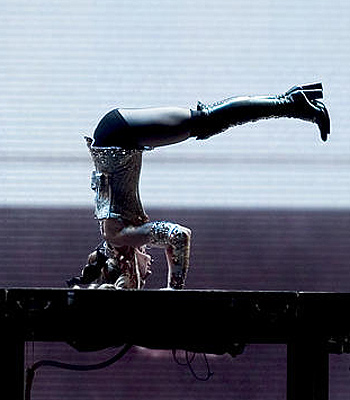
és egy másik celeb:
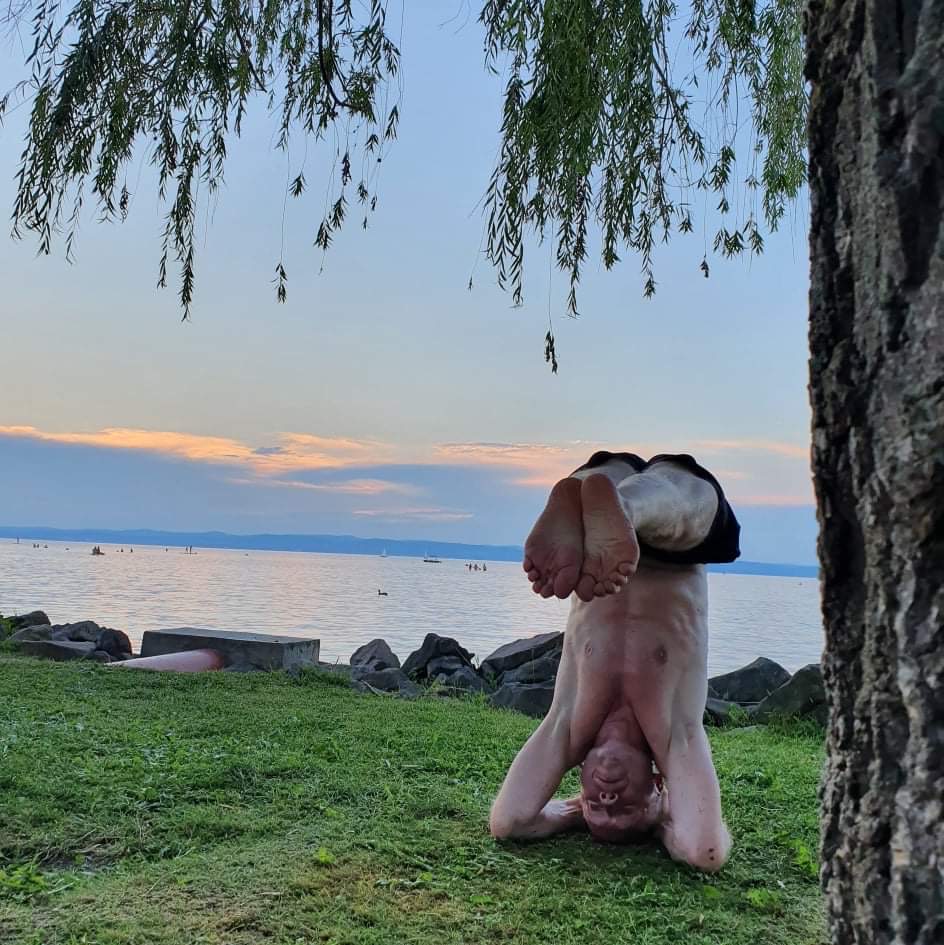
(Ez én vagyok. Ugyanaz az ászana, amit Madonna fentebb a színpadon “ad elő”. Ez 2021-ben készült azóta 7 kilóval nehezebb vagyok, de ez az ászana ugyanígy megy.
+1 megjegyzés ADHD-s olvasóknak: nem, a képen látható beömlő nem volt büdös. Csak nagyon kicsit. Bár az lehet, hogy a Balaton szaga volt. Már nem is emlékszem igazán.)
Hogyan álljunk neki?
- Kezdjük az alapokkal: Az astanga jógának sokféle pozíciója van, és a kezdők számára az alapokkal kell kezdeniük. Kezdetben javasolt a könnyebb pozíciók begyakorlása, amelyek az első sorozatban találhatók. A kezdeti fázisban az érzékenységre – test-érzetekre, a légzésre, és a helyes testtartásra kell fókuszálni. A legfontosabb ezek közül a légzés! A légzés – folyamatos be-ki – nélkül a jóga csak egyszerű torna. A légzéssel jön – a csoda. Imádni fogod.
- Tartsuk be a rendszert: Az astanga jógát minden alkalommal ugyanabban a sorrendben és ugyanabban a mennyiségben kell gyakorolni. A rendszeresen végzett gyakorlás segít a testnek az állandó mozgásban, a léleknek az összpontosításban és az elme egységének elérésében.
- Keressünk tapasztalt oktatót: Az astanga jógában a helyes testtartás és a légzéstechnika nagyon fontos, és egy tapasztalt oktató segíthet a helyes gyakorlásban. Keressünk olyan oktatót, aki tapasztalt, és aki tudja, hogyan kell egy kezdőnek segíteni elindulni az astanga jógában.
- Kezdjük kis lépésekkel: Az astanga jóga nagyon intenzív és fárasztó lehet, különösen a kezdők számára. Ezért javasolt kis lépésekkel kezdeni és fokozatosan emelni az intenzitást. Ha a test fájdalmat érez, akkor azonnal álljunk meg, és ne erőltessük túl magunkat.
- Fontos a légzés: Az astanga jóga során a légzéstechnika nagyon fontos. A helyes légzéstechnikával a testet oxigénnel látjuk el, és javítjuk az általános egészségi állapotunkat. Az astanga jógában a légzés segít az összpontosításban, az elme nyugalmában és a meditáció állapotának elérésében.
- Legyünk türelemmel: Az astanga jóga nagyon kihívást jelenthet, és a kezdőknek időre van szükségük ahhoz, hogy hozzászokjanak az intenzív mozgáshoz és a légzéstechnikához. Fontos, hogy türelmesek legyünk magunkkal, és ne várjunk azonnali eredményeket
Belenéznél? Íme a teljes gyakorlat-sor
Az első 1 perc az astanga mantra – átugorható – ennyi az “elmélet”. Onnantól – kezdődik a jó kis “meló”.
12 év jóga után is – akár én csinálom, akár mást látom, ahogy csinálja és jön az érzés. Dolgoztat, jó érzéssel fáraszt, nyugtat és a többi. Próbáld ki.
És itt pedig ugyanez egyetlen ábrában:
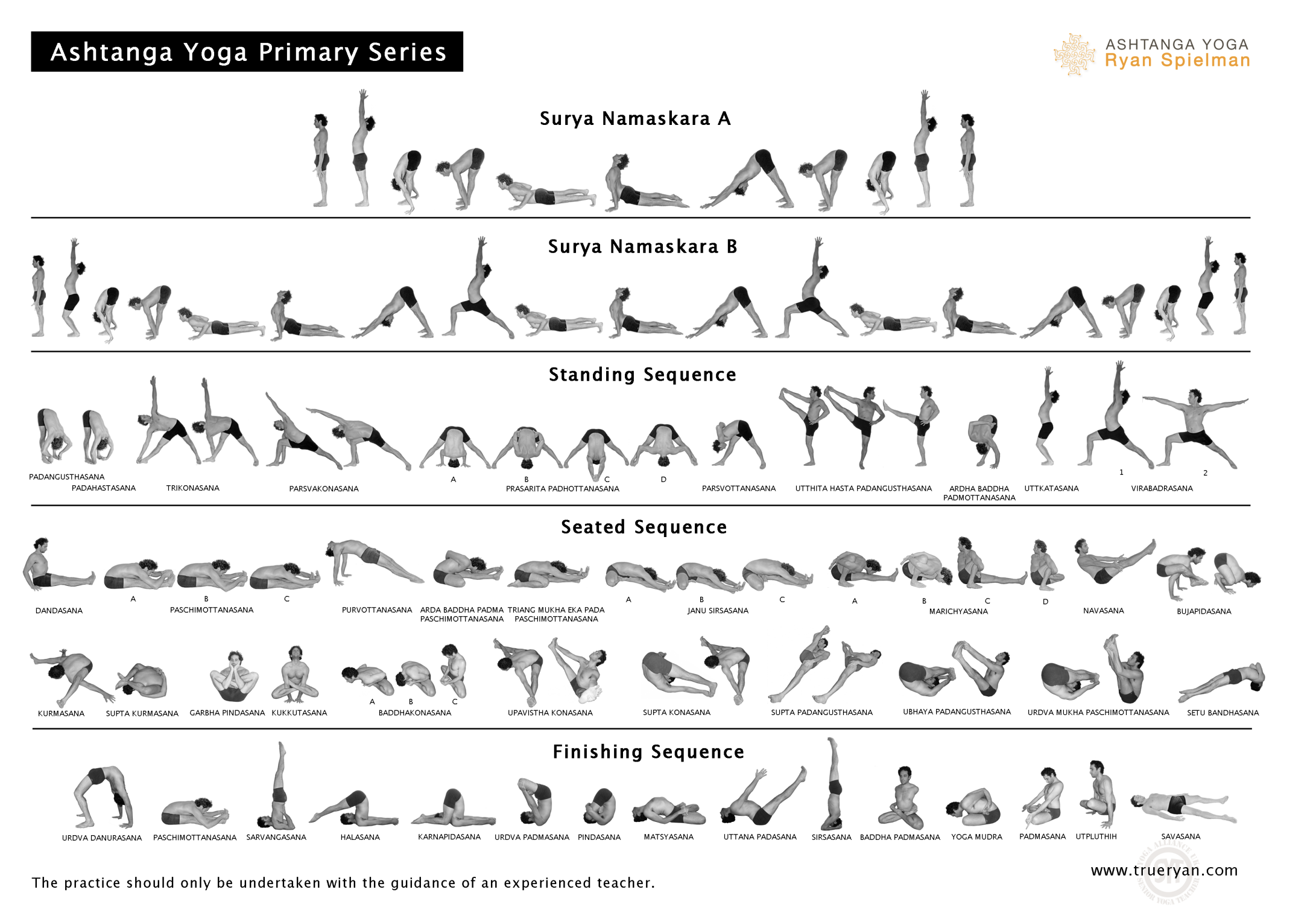
“Apró” megjegyzés: ha megnézed – az egész gyakorlatsor során 100+-szor teszed össze a két kezed (75 ászana van és 35 összekötő ún. vinyasa, az ászanák egy része 2 oldalra is van).
Emlékszel még a videóra a cikk elején?!? Hogy csak azzal, hogy összeteszed a két kezed: a két agyféltekéd szinkronba kerül.
Mit is mondtam? Az astangában semmi sem véletlen 🙂
Kifogások
Nem vagyok elég erős.
Nem vagyok elég rugalmas.
Nem vagyok elég kitartó.
Nem vagyok elég.
Nem lehet megtanulni, mert nem érek rá.
Nem enged el a férjem, mert sok a jó, rugalmas, nyitott, erős nő.
Nem enged el az asszony, mert sok a jó, rugalmas, nyitott, erős pasi.
Nem tudom a gyerek mellett.
Nem tudom a munka mellett.
Soha nem sportoltam, pont most kezdjem el?
Csak néha szoktam sportolni.
Nem vagyok rendszeres.
Nem vagyok kitartó.
Nem és kész.
Írd le ezeket egy lapra, tépd össze, aztán kezdd el.
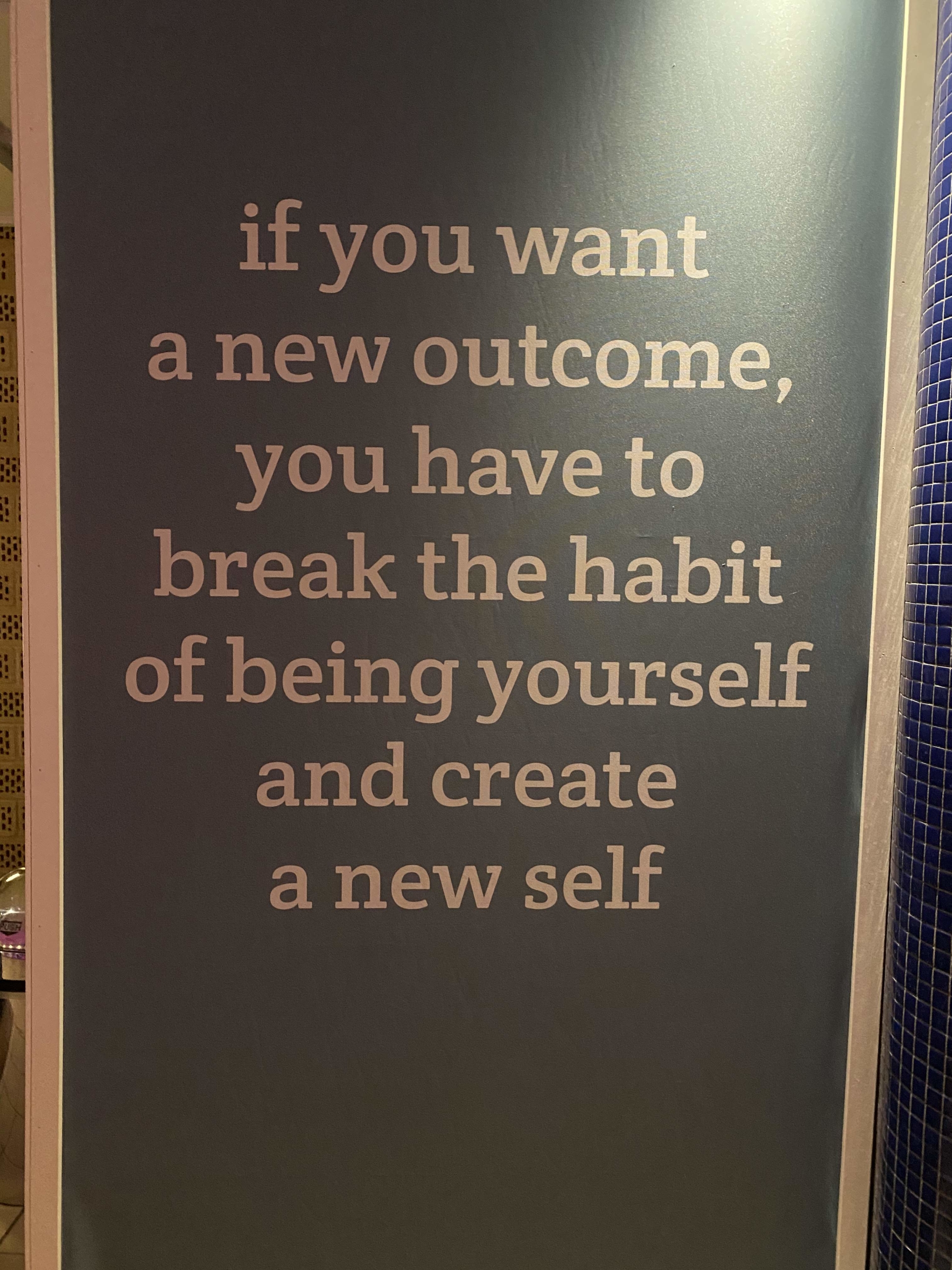
+1: a jóga nőknek való. Hát: a jógát 5000 éve igazi férfiak csinálták, gyakorolták és azóta is csinálják.

See you on the mat! 🙂
Utóirat: Meddig nehéz?
Mindig az lesz. De: az élet is az. Majd rájössz, ez miért is JÓ 🙂
Amúgy: keress rá: hogyan hat a légzéssel kombinált “nehézség” (testedzés) – ilyen a jóga is – az idegrendszerre.
Íme, pár keresési eredmény: itt a linken, katt.
És: volt már olyan, ami nagyon jó volt – és néha nem volt nehéz!? Na látod!
Utóirat – mi van az astanga nevében? A titok, amit senkinek nem mondok el, ezért ideírom, hogy mindenki lássa
Az ultra-szuper-zsenik, a valódi géniuszok a nevekbe rejtenek el – varázslatot, szarkazmust, humort.
Az astanga jóga neve sem véletlen.
Patthabi Jois adott mellé egy kulcsot: van egy mondása ugyanis, amit ismételt, gyakran:
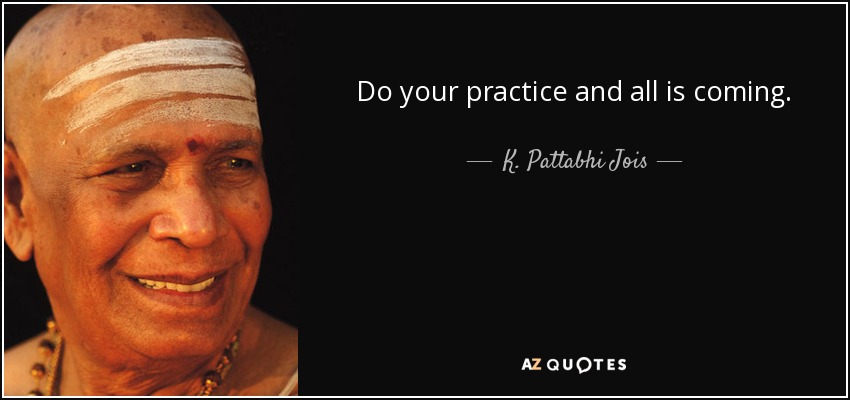
Azaz: gyakorolj és minden jön.
Még egy kis “súgás” tőle:
Mit is jelent ez?
Meggyőződésem, hogy ő úgy és annak találta ki az astanga jógát, hogy abban bizony: a jóga minden ága benne van. Nem kell külön légzőgyakorlatozni, meditálni, koncentrálni és a többi.
Csinálod – és jön. Hogy mi?
Na – mi is? 🙂
Mert: mi is az a “freedom” szankszritül? Kaivalya.
What is Ashtanga Yoga? And why will it blow your mind?
Ashtanga yoga is one of the most dynamic and intense forms of yoga that has enjoying great popularity in recent decades.
In 1 sentence – what is Ashtanga yoga?
6 series of exercises created in advance by a super genius from the previous 5000 years of asanas (asanas are gymnastic exercises, accompanied by breathing), which you learn once and can do anywhere and anytime throughout your life.
And: you will feel much better after doing it – always: physically, mentally.
Not from fat burning tea. From the antidepressant you take. From the wine you drink (although I also taste the latter, but only with utmost modesty). And so on.
One thing – whether you do it is up to you. If you do: it will feel much better. For sure.
Let’s start with it: what is it good for and why are you reading this here?
What is Ashtanga yoga?
They say – like yoga in general: is “experiential stuff”: you have to try it to tell.

In just a few words – at the same time it gives you:
– strength
– flexibility
– balance – physical and mental (if you are spinning, it calms you down, if you are lazy or tired, it gets you up and revs up, even without cola or coffee)
– calmness – there are a lot of separate articles and studies about how yoga and astanga yoga calms you down
– “flow” feeling: both directly and in a not that direct sense, see below
Note: its full name is astanga vinyasa flow. This, like nothing else is, it is not a coincidence.
And perhaps most importantly: amongst many other things: development, reflection, growth.
It contains everything that motivation researchers formulated 50 years ago: achievement, advancement, growth, work itself, responsibility.
And: all-day floating – it is a strong “drug” without real side effects, which makes you see more clearly.
A warm-up note: yoga is what you do, as well, at least I hope so
As a side note, I decided to write this whole article after seeing this video: One thing you must do to overcome Anxiety.
In other words: every practice is yoga, which practice balances your soul, body and mind. All.
Even the “practice” shown in the video above. Say, this is the first asana you ever learnt.
Drugs and antidepressants are not – they do more harm than good (apart from the exceptional cases when you take them because it is unavoidable, because there is no other choice).
I will describe below why I thought of writing this article, after watching this video.
Yoga? So you will sit for 1 hour?! No. Astanga is a – so-called dynamic, or flow yoga. And the primary series: yoga therapy
The most important characteristic of Ashtanga yoga is that it is constant flow motion. Patthabi Jois put together 6 series, of which most people in the world will practice the first series only, in their lifetime, which is called the “Primary Series” (are you surprised now!?) – by the way, the “official name” is of the primary series is yoga chikitsa – which translates as: yoga therapy. This is by no accident, either. As: when you practice, you realize: nothing is by accident in Ashtanga yoga.
See below – a nice short video – if you have 5 minutes and even if you’re a guy, you may…cry: a veteran and Ashtanga yoga
(in this video the yoga instructor calls it DDP yoga, but let’s forgive him, the guy is American – all the asanas that it you see in the video is Ashtanga yoga). From the fact that he can’t walk – to the point that…no spoiler, please.
And: it is perhaps one of the best commercials ever. 170 Million views or so.
Benefits of primary series?
The primary series is a healing practice. It resets the body so you can work on a deeper level. It’s for meditation, pranayama, and preparing the body for the advanced series.
Internally, the series targets the digestive system including your liver, gallbladder, and kidneys. It brings balance to both your sympathetic and parasympathetic nervous systems.
Each posture facilitates blood flow to targeted muscles. This causes them to soften and become more flexible. This circulation also flushes out the organs. It forces stagnant energy and toxins to move.
Who can practice astanga yoga?
Patthabi Jois:
“Anyone can practice. Young man can practice. Old man can practice. Very old man can practice. Man who is sick, he can practice. Man who doesn’t have strength can practice. Except lazy people; lazy people can’t practice Ashtanga yoga.”

Why “flow”?
It consists of 75 positions and takes one to one and a half hours. Each position in the sequence connects to the next, and the breath is synchronized with the movement.
I tell you: spoliler(!!!): the breathing and this continuous movement together: is THE point of it all. And where you look. This is the third. These are, together, where the “flow” feeling comes from.
What you wouldn’t give for the feeling of “flow”, right!? Well: there you go!
This means that every part of our body is in motion and energy flows through the whole body. The dynamics of Ashtanga yoga allow it to provide increased strength, flexibility, endurance, stability and balance.
Ashtanga yoga also means that all exercises should be done in the same order and in the same amount of time to achieve unity of body and mind. Breathing is important in Ashtanga yoga, which helps the mind and body focus and supports a meditative state. Ashtanga yoga is a type of yoga that can challenge those who already have yoga experience and is also accessible to beginners.
Why is it a “mirror”?
Have you ever thought about it – how boring predictability is?
When you always get the same thing?!?
The beginner – thinks so.
As in other areas of life: routine is boring at first look only, and you may feel: it is killing.
“The same asana sequence, for years!? Come on!”
And yet: think about it: predictability, routine: is a mirror: this is how you can face yourself and everything you have inside of you at that moment of practice.
No excuses, “today I’ll do a little of this”, “today a little of that”: the same exercises again and again. Every day. You will start to wonder: “Yesterday this asana worked, today it didn’t – what happened!?!?” – this doesn’t happen if you don’t do the same thing every day: and: as in other areas of life: sufficiently deep and difficult things are sufficiently deep and difficult – even if they are repeated. This is not a little back-scratching. 🙂 The harder it is the better.
In other words, astanga is exciting precisely because of the routine. You never know what you’ll find on that day, what it will bring out of you.
Quoting Patthabi Jois again:
“Exercises that are immensely unbelievably difficult at the beginning will become immensely difficult after 10-20 years of practice.”
Body and mind and soul – in one – and a source of ideas
It sounds trivial, but yoga works your mind and body at the same time.
And: when you are in a stiff body – also your mind is.
How do I know? Approx. 50% of my ideas are born on the yoga mat. I don’t want them to come – simply: they pop out of my head.
Why is this? Well, precisely because the brain wanders in a thousand directions. And when you’re not doing yoga – you’re stiff. Rigidity does not allow your brain – to live freely.
What does its name imply? It is by no coincidence, either
Even in its name, Ashtanga yoga is brilliant. At first the name is just: a copy. Anyone who already knows the way of thinking of the wisest, best, smartest people: you realize that in anything they invent or do to things close to their hearts – nothing is an accident.
For those with the need to know: in the yoga sutras, ashtanga is the 8 steps or branches of yoga.
There is already a little debate around this: whether one climbs the 8 branches or steps of yoga at the same time or one after the other – at first seemingly is a small thing, but it is not: the steps suggest that you start with 2 large groups of basic principles of yoga, and then with asanas – what Westerners know as yoga: these “I wrap myself in such and such a pose” type exercises and the rest of the steps, one after each other; the end of which is “liberation”, “enlightenment”. Sounds humble!? We know it does not. The “branch” suggests that you can achieve “enlightenment” right at the beginning of yoga, when you are a beginner; its depth and length that changes as you progress.
About the rest – why Patthabi Jois, the founder of astanga yoga, brilliantly and wisely called his yoga astanga, when it is actually “just” a series of asanas, and not the COMPLETE 8 branches or steps of yoga which the Yoga Sutras write about. ..well, you can read more on it below.
Side-note: Yoga is: 5000 years of wisdom
Yoga has its roots in India and dates back more than five thousand years.
There is a city next to Varanasi: Sarnath: there is a museum where the finds, sculptures, works of art can be seen in chronological order – up to BC. 3000 and before to the present day. The first sculptures: meditating figures with broken arms, legs and heads (some of which are missing several body parts). When I saw it for the first time: I was shaken by the cold and my feet were rooted to the ground.

That was the point when I understood the words of my friend, Suresh, who had welcomed me in Delhi earlier on: “Peter, why would you throw away 5000 years of wisdom, right?!” (and he laughed). I had found this behavior a bit arrogant back then. Then, after having seen these 5000+ year old statues doing different yoga poses – I no longer found any arrogance in his earlier sentence.
So we could have written the same sentence this way, precisely because of the above:
ASTANGA yoga has its roots in India and dates back more than five thousand years.
Now you think here – we are joking. But – we do not. Or just: a little.
(because originally, let’s just repeat it: astanga yoga originally is the entire yoga sutras themselves: from beginning to end; then there comes a maniac, a genius, Patthabi Jois and names his system of asanas (a series of asanas put together) astanga).
OK, what about the Yoga-sutras?
It is a practical manual – just and only; not a religious work, not a fairy tale, not an esoteric hallucination – it is “just” about how to be (even if we can see it) selfish (as it is endlessly selfish, to the extremes, if you think about it) – so how can you be independent of everyone and everything: just be: free.
This is the state of kaivalya – which is the “end” of the 8th branch, because the this means: to get rid of. To be free.
When did Ashtanga yoga become known? Who some famous celebs?
Pattabhi Jois, or as he is often called, Guruji, was born in 1915 in South India. He encountered yoga at a young age and later learned yoga as a student of his master, Krishnamacharya, at the Ashtanga Yoga Research Institute in Mysore (India). In the 20th century, Jois developed and passed on yoga, which he gave the name Ashtanga yoga. He said that Ashtanga Yoga was developed based on ancient legal traditions and is a perfect unity between body, mind and spirit.
Some celebs who practice astanga are:


Madonna

and another: 🙂

(Well – that’s me. It’s the same asana that Madonna “performs” on stage, in the picture above. This was taken in 2021; now I’m 7 kgs heavier since then, but this asana still works the same way for me.
+1 note for readers with ADHD: no, the pipe in the picture did not stink. Or just a little. Although it might have been the smell of Lake Balaton – do I know this!?!? I cannot remember, really.))
How to start?
I already know how not to: there are professional yoga studios where beginners are not even allowed to enter. You can go there, but they won’t let you on to the mat.
Therefore, you have two ways: either you ask someone who has been practicing for a long time and start with them.
Or go to a 4-5 occasions yoga course, where they teach you the first series (typically the first half of it).
Additional pieces of advice from chatGPT – and me, joining forces together:
Let’s start with the basics: Ashtanga yoga has many different positions and beginners should start with the basics. In the beginning, it is recommended to practice the easier positions, which are found in the first series. In the initial phase, you have to focus on sensitivity – body sensations, breathing, and correct posture. The most important of these is breathing! Without breathing – continuous in and out – yoga is just simple gymnastics. With breathing comes – the miracle. You will love it.
Follow and trust the system: Ashtanga yoga should be practiced in the same order and in the same amount every time. Regular practice helps the body to move constantly, the soul to focus and achieve unity of mind. Do not worry if it will do some damage to your body!
Find an experienced instructor: Correct posture and breathing technique are important in Ashtanga yoga, and an experienced instructor can help you practice correctly. Let’s look for an instructor who is experienced and who knows how to help a beginner get started in Ashtanga yoga.
Let’s start with small steps: Ashtanga yoga can be very intense and exhausting, especially for beginners. Therefore, it is recommended to start with small steps and gradually increase the intensity. If the body feels pain, stop immediately and do not overexert yourself.
Breathing is important: Breathing technique is very important during astanga yoga. With the correct breathing technique, we supply the body with oxygen and improve our general state of health. In Ashtanga yoga, breathing helps to focus, calm the mind and achieve a state of meditation.
Be patient: Ashtanga yoga can be very challenging and beginners need time to get used to the intense movement and breathing techniques. It is important to be patient with yourself and not expect immediate results
Do you want to peek in? Here we go – the full primary series for you
The first 1 minute is the astanga mantra – it can be skipped – that’s all the “theory”. From there – the real work begins.
Even after 12 years of yoga – whether I do it myself or I see someone else doing it: the feeling comes. It makes you work, makes you tired with a good feeling in the back of your mind, calms you down and you will have an unbelievably good rest. Try it.
The same in one small chart:

“Small” side-note: if you look at it – during the entire primary series you put your two hands together 100+ times (there are 75 asanas and 35 connecting so-called vinyasas, some of the asanas are also on 2 sides).
Can you still remember the video at the start of this article?!? That just by putting your two hands together, your two brain hemispheres get in sync.
What did I say? Nothing in Ashtanga is a coincidence 🙂
Excuses
I’m not strong enough.
I’m not flexible enough.
I’m not persistent enough.
I’m not enough.
It can’t be learned because I’m not good enough.
My husband won’t let me go, because there are many good, flexible, open, strong good looking men.
The woman won’t let me go, because there are many good, flexible, open and strong looking women.
I don’t know who will take care of my childre.
I don’t know how to fit it into my work routine.
I’ve never exercised, should I start now?
I only do sports sometimes.
I’m not persistent.
I cannot.
Write down these excuses on a piece of paper – tear it – and just do it.

+1 excuse: “yoga is for women”. Hell not. In the old days, for 1000’s of years real men did yoga. And they still do.

See you on the mat! 🙂
Last note: how long will it be hard?
It always will be. But: so is life. You will find out why this is GOOD 🙂
By the way: look it up: how “difficult exercise” combined with rhythmic breathing () – this is also the case with yoga – affects the nervous system.
The 1st 1-2 months will be harder but then it will be gradually better and better. Trust me 🙂
Postscript – what’s in the name of astanga? The secret I don’t tell anyone, so I’m writing it here for everyone to see
Ultra-super-geniuses, real geniuses hide magic, sarcasm, humor in names they give to things.
The name of Ashtanga yoga is by no accident either.
Patthabi Jois gave us a key: he had a saying he often repeated:

One more hint from Jois:
What does this mean?
I am convinced that he invented Ashtanga yoga in such a way that it contains all the branches of yoga. There is no need to do special breathing exercises, meditation, concentration and the rest.
You do it – and it comes. What?
So what? 🙂
Because: what is “freedom” in Sanskrit? Kaivalya.
